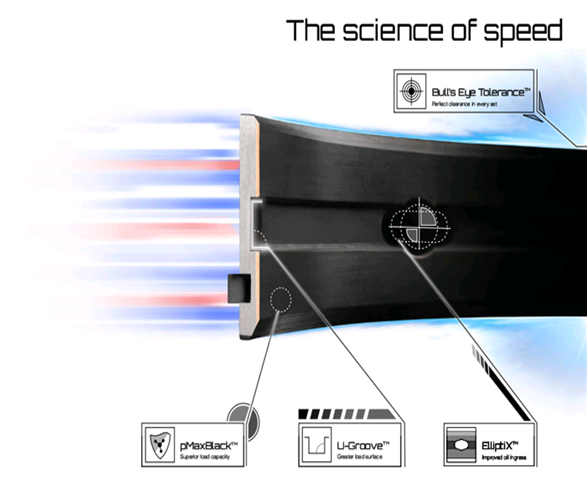Main page
About us
Sliding Bearings Consulting
Advertising Opportunities

SubsTech’s sister website Smooth Sliding provides independent engineering consulting services that help you to solve engine bearing related issues: failures, material selection, geometry design and optimization of hydrodynamic conditions.
Smooth Sliding is an engineering consulting company run by Dr. Dmitri Kopeliovich:
- VP R&D of King Engine Bearings.
- World leading expert (32 years of experience) in design, technology and materials for Engine bearings in applications such as automotive, renewable energy, aviation, racing and others.
- Founder and owner of SubsTech (Substances & Technologies) – a leading professional website on Materials Science and Engineering.
- Author of numerous scientific and engineering publications and patents.
- Founder and owner of Smooth Sliding.
For further information and for requesting consulting services please visit our sister website Smooth Sliding.
to Metals
to Engine bearings
EccentriX™ Optimal Eccentricity for High Performance Bearings
Introduction
Engine bearings function as hydrodynamic bearings, in which a rotating journal produces a hydrodynamic force pressurizing the lubricant flowing between the journal and the bearing surfaces [1]. The pressure does not allow the journal to contact the bearing surface since it acts in the direction opposite to the direction of the external load. The surfaces are separated by a film of oil that is being continuously squeezed through the gap between the journal and the bearing.
A loaded rotating journal is always displaced from the concentric position, forming a converging gap (wedge) between the bearing and journal surfaces (Fig.1). The presence of an oil wedge is indispensable to the normal operation of a hydrodynamic bearing.
As seen in Fig.1, the pressure in the oil film is not distributed uniformly over the bearing surface. The distribution has a peak close to the location of minimum oil film thickness. The value of the peak is dependent on the average load applied to the bearing, the journal rotation speed, the lubricant viscosity and the value of journal eccentricity e relative to the bearing. The more the journal center has shifted from the bearing center, the higher the hydrodynamic force generated by the rotating journal.
Thus eccentricity is a fundamental parameter of a journal bearing.

to top
Eccentricity of Engine Bearings
According to Fig.1, the maximum theoretical value of a bearing’s eccentricity is equal to the difference between the radius of the bearing and the radius of the journal (the radial oil clearance).
A great difference between their radii (or diameters) helps to establish stable hydrodynamic lubrication, especially at high rotation speed. On the other hand, a bearing with a diameter significantly greater than the diameter of the journal may produce vibration and knocking in the regimes of low loads or under alternating load. Such knocking may cause bearing failure due to material Fatigue.
In order to increase bearing eccentricity without changing the oil clearance, the inside bearing surface is produced not round. It has a lemon shape due to the varying thickness of the bearing wall, having its maximal value at the centerline (T) and gradually decreasing towards the parting line [2]. It is accepted to measure the minimal value of bearing wall thickness (Te) at a certain specified height h (Fig.2), in order to exclude the zone of crush relief.
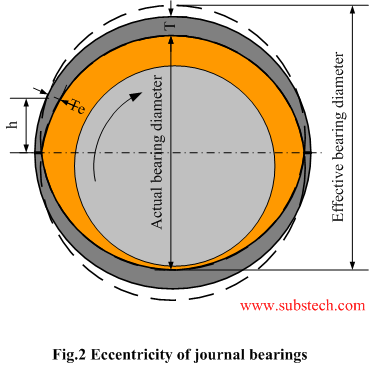
The shape related to bearing eccentricity is equal to the difference between the maximum and minimum wall thickness:
eccentricity = T - Te
Eccentricity, produced by the varying wall thickness, is added to eccentricity e, which is caused by the displacement of the journal from the concentric position (Fig.1).
Such increased total eccentricity enables a more stable hydrodynamic regime.
With regards to hydrodynamic conditions, a bearing with eccentricity is equivalent to a bearing with increased diameter (or increased oil clearance). The oil wedge of a bearing with eccentricity is the same as the wedge formed by a bearing with increased diameter (”effective bearing diameter”). However, since actual bearing diameter is not changed, the adverse effect of noise and vibration from excessive bearing clearance is prevented.
to top
Eccentricity Issues of High Performance Bearings
High performance engines commonly operate at high rotation speeds, which considerably increase the inertia forces generated by the accelerating/decelerating engine parts (e.g. the assembly of a piston with the connecting rod).
Since the values of inertia forces are proportional to the square of the rotation speed, they become high at high rotation speeds. For example, an increase of rotation speed from 2000 to 6400 RPM raises the inertia forces by 10 times.
In reaction to these inertia forces, the connecting rod and its bore are stretched in a vertical direction. As a result, bearing diameter measured along the parting line decreases (closes-in), changing the shape of the oil wedge. If the eccentricity of the connecting rod bearing is insufficient, the oil wedge may change its shape from converging to diverging (negative wedge). Such conditions are shown in Fig.3. Under negative oil wedge conditions, a hydrodynamic regime of lubrication is impossible. The bearing will be subject to direct friction, characterized by metal-to-metal contact between it and the crankshaft journal surface.
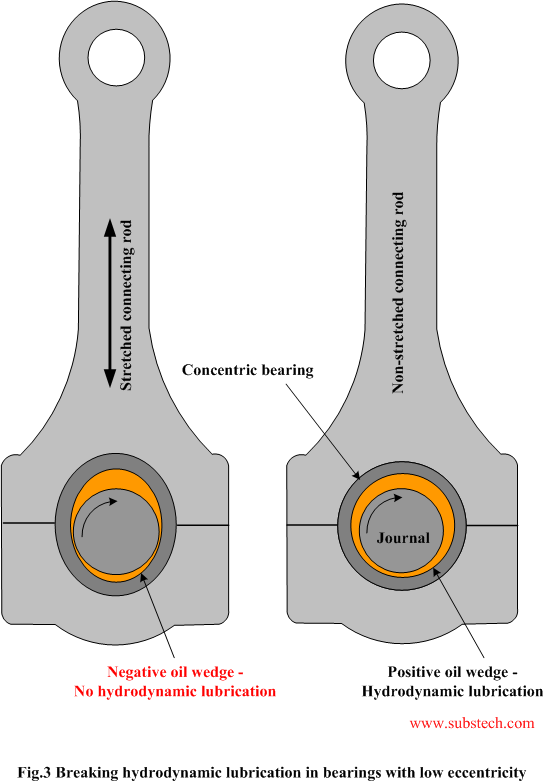
The crankcase bores may also change their shape as a result of high loads applied to the main bearings. Therefore a similar problem may occur with them.
Bearing eccentricity should be designed to compensate for the distortions of bearing housing bores caused by the forces applied to the connecting rod and to the crankcase. Bearing eccentricity should enable and allow for the creation and retention of a wedge shaped oil gap, which is required in order to produce a hydrodynamic lubrication regime. (Fig.4).
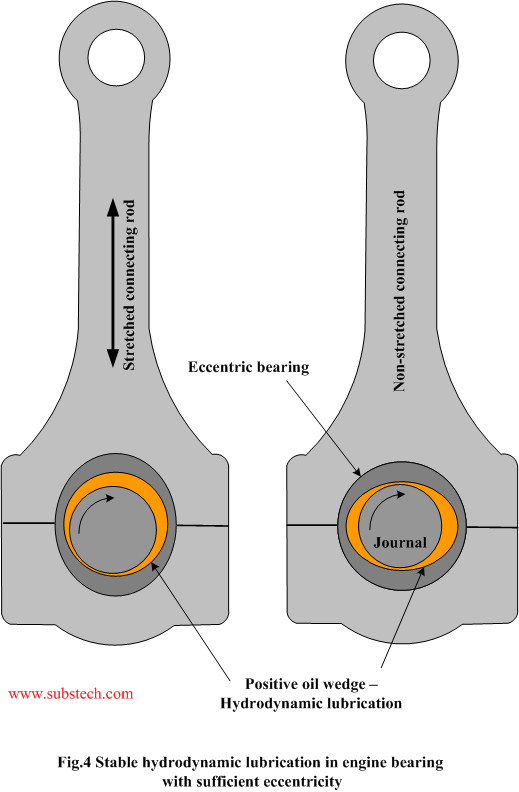
King performance engine bearings, designed to operate at high rotation speeds and high loads, are produced with increased eccentricity - the amount of which is calculated for each application.
to top
Theoretical Optimization of Eccentricity for High Performance Bearings
The parameters of hydrodynamic lubrication of bearings [3] with various values of eccentricity were theoretically calculated using software developed by King Engine Bearings. This software is capable of calculating loads, minimum oil film thickness, oil temperature rise, energy loss, oil flow rate and other thermodynamic, dynamic and hydrodynamic parameters for each bearing of an engine, at any angular position of the crankshaft.
A racing car engine equipped with high performance King CR 807XPN (connecting rod bearings) and MB 557XP (main bearings) was taken as an example for the calculations. The calculations were made for connecting rod bearings in an engine rotating at 2500, 6000 and 8000 RPM.
The results of the calculation for minimum oil film thickness of the bearing with four various values of eccentricity (0, 0.4, 0.6, 0.8 and 1.2 mil) of the CR 807XPN are shown in Fig.5.
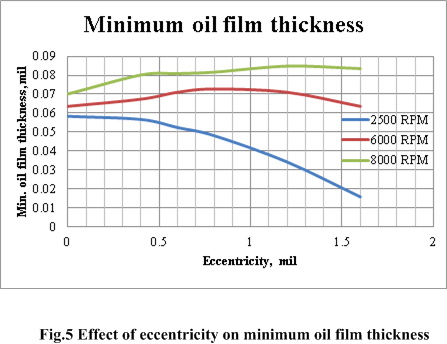
At the low rotation speed of 2500 RPM, which is more characteristic of street engines rather than racing engines, an increase of eccentricity beyond 0.5 mil causes a decrease in minimum oil film thickness. The hydrodynamic force developed by the bearing at greater eccentricity is not sufficient to retain a relatively high level of minimum oil film thickness at low rotation speeds.
The sharp decrease in minimum oil film thickness at 2500 RPM is accompanied by a more than 50% reduction in oil flow (Fig.6) and a rapid transition to non-uniform oil pressure distribution (Fig.7).
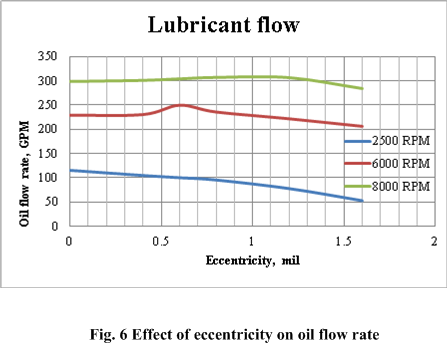
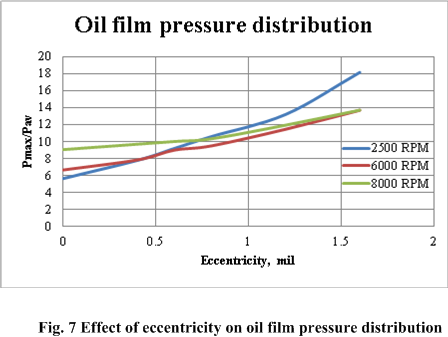
At higher amounts of eccentricity, hydrodynamic lubrication becomes more stable if the rotation speed is increased to 6000 RPM. Minimum oil film thickness grows with an increase of eccentricity and reaches a maximum at 0.8 mil. Further increase of eccentricity causes a slight decrease in minimum oil film thickness. The oil flow rate lowers much more gradually than at the speed of 2500 RPM. The effect of eccentricity on peak pressure is also weaker than at lower speed.
The calculations show that at 8000 RPM the parameters of hydrodynamic lubrication remain responsive to the amount of eccentricity. In fact, the maximum value of minimum oil film thickness (Fig.5) was achieved at a greater value of eccentricity (1.2 mil). The absolute level of minimum oil film thickness was also the highest. The oil peak pressure grew more gradually than at lower speeds. The effect of eccentricity on the oil flow rate (Fig.6) is negligible.
Thus, the optimal value of eccentricity for engine bearings depends on the typical rotation speeds of the engine. The higher the rotation speed the greater the role eccentricity plays in providing the best combination of hydrodynamic parameters for the bearings.
to top
Validation of Eccentricity in Test Rig Machine
The tests were performed on the test rig designed and manufactured by King Engine Bearings (Fig.8)
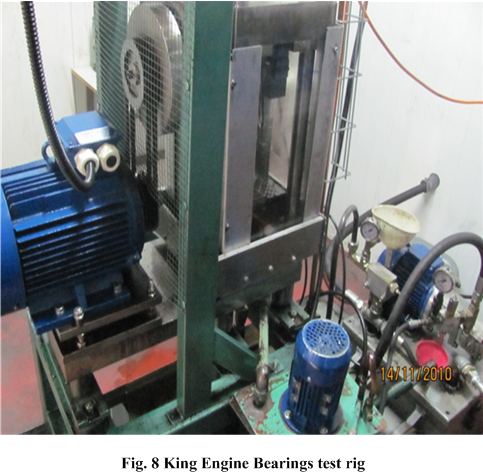
The test rig uses an eccentric shaft located between two concentric shaft parts [4]. The test bearing, coupled with the eccentric shaft, is mounted in the big end of the connecting rod. Rotation of the eccentric shaft results in reciprocating motion of the connecting rod. The shaft is driven by an electric motor. The rotation speed of the test rig may be varied within the range of 1500-5000 RPM. The load is created by the hydraulic cylinder.
Experimental bearings (C 697XP) with three different values of eccentricity (0.2, 0.8 and 1.4 mil) were tested at a specific load of 9000 psi.
Test duration: 24 hrs;
Rotation speed: 5000 RPM
Number of cycles: 7,200,000
Rig Tests Results:
The bearing with 0.2 mil eccentricity (Fig.8) has a region of slight wear in the central bearing area. This was caused by intermittent metal-to-metal contact between the journal and bearing surfaces. This indicates that the minimum oil film thickness was very close to the heights of the micro-asperities on the journal surface.
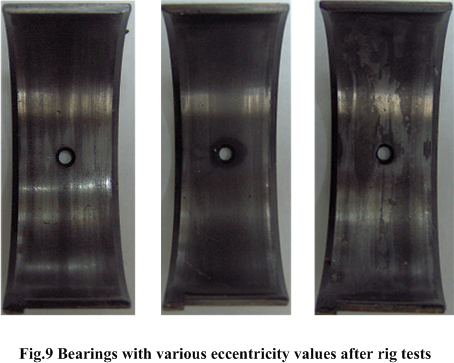
The bearing with eccentricity increased to 0.8 mil worked in a purely hydrodynamic regime of lubrication. Its surface did not wear and it retained the original color characteristic of King XP high performance bearings.
The bearing with the greatest eccentricity, 1.4 mil, caused a sharp drop in the minimum oil film thickness, resulting in a more severe wear of the overlay.
The test results have proved the findings obtained theoretically.
to top
Conclusions – EccentriX™ Protocol
- Bearing eccentricity helps to establish stable hydrodynamic lubrication without the adverse effect of noise and vibration caused by excessive bearing clearance
- Bearing eccentricity enables creating and retaining the wedge shape of the oil gap, even in a distorted housing.
- According to the theoretical calculations, the higher the rotation speed the greater the value of eccentricity required in order to optimize the following critical hydrodynamic parameters: minimum oil film thickness, oil flow and peak oil film pressure.
- Experimental validation of bearing operation in King’s test rig, using shells with different eccentricity values, has proved the conclusions obtained theoretically.
References
[1] Dudley D. Fuller (1958), A Survey of Journal Bearing Literature, Amer. Soc. of Lubricating Engineers
[2] Dmitri Kopeliovich (2011), Geometry and Dimensional Tolerances of Engine Bearings, Engine professional, AERA., p.70-76.
[3] J.E. Shigley (1986), Mechanical engineering design, McGraw-Hill Book Company.
[4] Dmitri Kopeliovich (2013), Engine bearing fatigue test, SubsTech (Substances&Technologies), Available from http://www.substech.com/dokuwiki/doku.php?id=engine_bearing_fatigue_test
to top
Related internal links
to Metals
to Engine bearings



